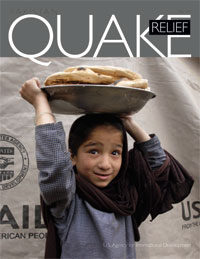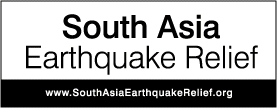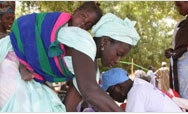 |
Earthquake Relief Update

Click to download the
Pakistan Quake Relief publication
(PDF, 4.2mb)
| A Commitment to Reconstruction
On November 19, 2005, the U.S.
Government actively engaged other
donors to support relief and
reconstruction at the Donors Conference
in Pakistan. In all, 75 countries and
international organizations pledged $6.2
billion in post-earthquake assistance, a
demonstration of international support.
The U.S. pledged a total of $510 million. |
| USAID Relief and Transition |
| Pledged: | $70 million |
| Obligated to Date: | $69.3 million |
| Food and Refugee Relief |
| Pledged: | $24 million |
| Obligated to Date: | $32.7 million |
| Military Assistance |
| Pledged: | $110 million |
| Obligated to Date: | $133.5 million |
| Private Sector Contributions |
| Pledged: | $100 million |
| Donated to Date: | $151.75 million |
| Reconstruction over 4 years |
| Pledged: | $206 million |
| Obligated in FY 2006: | $55 million |  |
|

The South Asia Earthquake Relief Fund was formed when five distinguished private-sector leaders, supported by President Bush, launched a nationwide effort to encourage private donations for relief and reconstruction in response to the devastating earthquake in South Asia that occurred on October 8, 2005. |
One Year Retrospective:
The United States’ Response to the South Asia Earthquake
A magnitude 7.6 earthquake struck Pakistan, India, and Afghanistan on October 8, 2005. Its epicenter
was located near Muzaffarabad, the capital of Azad Jammu and Kashmir (AJK) and approximately 60
miles north-northeast of Islamabad. Aftershocks continue in the affected areas. An estimated 74,000
Pakistanis died, 70,000 were seriously injured, and over 2.8 million were left homeless. Mountainous
terrain, cold weather, and collapsed infrastructure hindered the delivery of humanitarian relief. Ninety
percent of the deaths and injuries occurred in AJK and in the North West Frontier Province (NWFP).
The US Government Responds
The U.S. response was immediate and massive. Within 48 hours of the earthquake, the first CH-47
Chinook helicopters arrived from Afghanistan. At the height of disaster relief operations, the U.S. Army
provided 21 CH-47s simultaneously. By October 10, USAID’s Disaster Assistance Response Team
(DART) had established a headquarters in Islamabad and forward operating bases in Muzaffarabad and
Mansehra, in NWFP, to help coordinate the relief effort. Focusing on immediate humanitarian needs, U.S.
Government assistance provided emergency shelter, relief supplies, and medical help in close
coordination with the Government of Pakistan, local authorities, and international organizations.
Although the earthquake left more than 2 million survivors homeless, the quick and sustained response to
the earthquake helped avert deaths from injury, lack of shelter, or severe outbreaks of disease.
- 370,000 people in the affected areas received relief
commodities through a vast airlift of urgently needed relief
supplies beginning within 24 hours of the earthquake.
USAID completed 25 flights of emergency relief commodities
that delivered 97,725 blankets; 1,570 winterized tents; 8,050
rolls of plastic sheeting for shelter for 36,672 families; 15,000
water containers; 17 water bladders and two purification
units; 10 WHO emergency health kits; 20 concrete cutting
saws; and 136 shelters donated by Alaska Structures.
- 5,912 relief operations were flown by U.S. military and
government helicopters. With the roads across the region
blocked by rubble, these sorties delivered 14,322 tons of
relief supplies and transported 19,638 people, including over
4,547 needing medical attention.
- 35,000 people received emergency medical treatment—
and another 20,000 were inoculated at U.S. military hospitals
in Muzaffarabad and Shinkiari, helping prevent severe
outbreaks of disease. In March 2006, at the conclusion of
relief operations, the U.S. Army donated to Pakistan its last
Mobile Army Surgical Hospital (MASH), the site of over 400
operations and emergency care for 20,000 patients during
the relief effort.
- 1,000 tons of relief supplies and 107 pieces of heavy
engineering equipment were delivered in a coordinated effort involving seven U.S. military vessels.
Separately, a U.S. Navy construction battalion completed a dozen projects, clearing over 50,000
cubic yards of debris and building 85 temporary shelters, many of which were used for schools.
Relief efforts in the days and weeks after the earthquake helped meet the urgent needs of the millions of
people who lost their homes and livelihoods shortly before the beginning of winter. From October 2005 to
March 2006, the U.S. Government continued emergency relief efforts, providing essential shelter and
access to healthcare, food, and water.
- 596,000 people received
emergency shelter materials
including corrugated galvanized iron
(CGI) sheets, plastic sheeting,
household kits, winterized tents,
blankets, shelter kits, quilts, and
toolkits. USAID’s partners are
continuing to assist earthquakeaffected
families by constructing
temporary shelters and providing
technical assistance and training for
the construction of durable shelters.
- 80,000 people in affected areas
gained access to essential
healthcare though support to the
Ministry of Health. Additionally, more
than 3,700 children received
psychological and social assistance through the construction and support of safe play spaces. USAID
also established 228 tent schools, and provided textbooks and school supplies across affected areas.
- 57,000 people gained access to safe drinking water through an effort to rehabilitate 100 village
water systems and the creation of water infrastructure in camps. Other efforts improved access to
sanitation facilities for more than 109,000 people. Hygiene education programs reached over 70,000
people, helping prevent the spread of disease.
- 7,270 metric tons of Title II emergency food assistance was provided by USAID in response to
the UN World Food Program emergency and follow-on recovery operation for Pakistan.
- 48,500 days of work were created and paid for through livelihoods programs that provided income
for those in the affected areas. These cash-for-work programs supported the restoration of water
supply systems, road clearance, vocational training, and rubble removal. Over 15,500 households
received $100 vouchers, enabling earthquake-affected people to replace household supplies and
construction equipment.
On October 27, five private-sector CEOs launched the South Asia Earthquake Relief Fund to spearhead
private fundraising. To date, it has received over $19 million in cash and pledges, and has allocated $4.5
million to five organizations focused on relief efforts, with remaining funds for reconstruction. Ambassador
Randall L. Tobias, Director of U.S. Foreign Assistance, sits on the Fund’s Advisory Committee.
Transition Programs
With an end to winter and the conclusion of emergency relief efforts, USAID initiated a series of transition
programs to help people return home and rebuild their communities. Beginning in April 2006 these
programs are helping residents establish the foundation for long-term recovery, preventing a second
wave of displacements when winter returns.
During the transition period from April to October 2006, USAID is focusing resources in Bagh Tehsil and
the Kaghan and Siran valleys. USAID is also assisting populations in the Allai Valley, having returned to
their homes from Mehra Camp. To assist in creating sustainable communities, USAID is supporting broad
reaching programs designed to address the many needs of the recovering communities.
- Cash-for-work. Clearing rubble. Households across the affected areas are receiving much needed
support as they clear away collapsed buildings and restore irrigation systems. In Muzaffarabad,
USAID support has helped remove nearly 80 percent of rubble, the first step in rebuilding homes and
businesses in the urban center.
- Delivering water. Water and sanitation systems are being restored in hundreds of rural villages
- Restoring livelihoods. During the transition period, livelihoods programs have focused on vocational
training, restoring community infrastructure, and agricultural assistance needed to jumpstart the
summer and fall planting. Voucher programs have given households the tools they need to rebuild.
- Rebuilding homes. At reconstruction hubs across the region, skilled and unskilled laborers are
receiving training in earthquake-resistant construction. To support the Government of Pakistan,
USAID programs are training Pakistani officials and Army engineers who will inspect compliance with
earthquake-resistant housing construction standards. Additionally, USAID is continuing to provide
essential shelter materials to the most vulnerable families.
Reconstruction
Beginning in October 2006, USAID’s four-year, $200 million Earthquake Reconstruction program will
rebuild schools and hospitals, improve education and health services, and improve economic well being
in the earthquake-affected areas of NWFP and AJK.
- Construction. Building back better is the underlying theme of the reconstruction program. Meeting
earthquake-resistant building standards, USAID will build, furnish, and equip primary healthcare
facilities and local hospitals as well as primary, middle, and high schools. During the first year of the
program, USAID will begin construction of 50 schools and 15 healthcare facilities, including the
construction of the Tehsil Headquarters Hospital in Bagh. The Model Boys School in Dadar, to be
reopened October 2006, is the pilot project of this larger effort. ($130 million over five years)
- Health. USAID will work with health officials and citizens to integrate, improve, and expand the
network of health services for residents of the earthquake-affected areas. Regional hospitals and
clinics will be able to ensure that people have better access to vital medical care by providing
services that have a huge impact on health and survival. ($28 million over four years)
- Education. Working with district education offices, teachers, and parents, USAID will help
communities in the earthquake areas improve the quality of classroom instruction. Some 5,000
elementary, middle, and high school teachers will be trained in student-centered instruction, math,
and science. USAID will also mobilize
community participation by building effective
parent associations that will assist in school
reconstruction. ($13 million over four years)
- Livelihoods. Finally, USAID will work to
recover and expand the economy of the
earthquake-affected areas through activities
aimed at households and businesses. This
program will help remote farmers and
herders as they re-establish and expand
crop systems, restore and care for livestock,
repair water systems, and restore orchards,
leading to better income opportunities.
Women and vulnerable populations will
make up at least 35 percent of the
beneficiaries. ($28 million over three years)
Back to Top ^
|


